IS-800, An Overview of the National Response Framework in Common English
IS-800 certification is required for an EMT to work on a Disaster Management Assistant Team (DMAT) and is required for many first responder positions.
The good news is that the class for IS-800 is free and can be completed online; the bad news is the student manual takes English to a Category 5 level of officialese. This article exists to bring some structure to the subject.
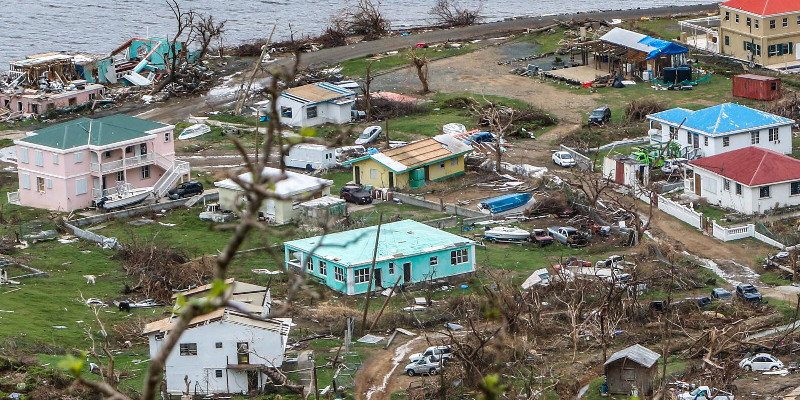
The National Response Framework in the Greater System
It is recommended that you read An Overview of the Incident Command System (ICS) in Common English if you have not already.
The first point to clarify is that IS-800 deals with systems that have confusing and similar sounding names:
- The National Preparedness Goal.
- The National Preparedness System.
- The National Response Framework.
For initial purposes, the National Preparedness Goal (1) is simply a sentence with five noteworthy verbs:
A secure and resilient nation with the capabilities required across the whole community to prevent, protect against, mitigate, respond to, and recover from the threats and hazards that pose the greatest risk.
The verbs (prevent, protect, mitigate, respond, and recover) are called Five Mission Areas elsewhere in FEMA literature.
The National Preparedness System (2) is a system that contains the National Response Framework (3.)
The National Response Framework is itself a system intended to help manage disasters, meaning large incidents such as multi-state tornado outbreaks, hurricanes, and blizzards. (A two-car motor vehicle collision might be a disaster for the persons involved, but it would not be considered a disaster in the Framework's context.)
Keep in mind that the National Response Framework is the primary subject of IS-800 and this article.
All of this shall be much clearer in a moment when looked at graphically, but for grins and giggles, try to understand the following description of the National Response Framework derived from FEMA officialese.
The National Response Framework is one of five frameworks overlying the six-part National Preparedness System which correspond to the National Preparedness Goal's Five Mission Areas. The National Response Framework focuses on the National Preparedness Goal's Whole Community, and shares the National Preparedness Goal's 32 Core Capabilities. It builds on the National Incident Management System and aligns with the 14 NIMS management characteristics.
The big picture (with the National Response Framework highlighted in orange) looks something like this:

The Whole Community
The arrows on both ends of the orange National Response Framework in the image above are intended to draw attention to the Whole Community. The Whole Community is a recurring theme in FEMA response literature. The idea is to not overlook anybody in any of the mission areas, especially response.
The Whole Community includes the mentally challenged, prisoners, those in wheelchairs, the blind, our elders, the homeless, those living on Indian reservations, corporations, volunteer organizations, those living in insular (or island) jurisdictions (such as Guam and Puerto Rico,) and, to the a certain extent, pets and livestock.
The National Preparedness Goal
As mentioned earlier, the National Preparedness Goal is simply a sentence. The reality, however, is much more complicated.
The National Preparedness Goal is described (at least) two ways in FEMA literature. The first is the sentence worth repeating:
A secure and resilient nation with the capabilities required across the whole community to prevent, protect against, mitigate, respond to, and recover from the threats and hazards that pose the greatest risk.
The second description of the National Preparedness Goal is as a system the contains the sentence as a component. This second description seems to be closest to reality, so we will assume that the National Preparedness Goal is a system with a guiding sentence and that both the system and the statement have the same name.
The National Preparedness System
Although I used rectangles in my big-picture graphic, the National Preparedness System is depicted in FEMA literature as a circular web of six parts overlying a foundation mixed of the Whole Community, the Core Capabilities, and NIMS:
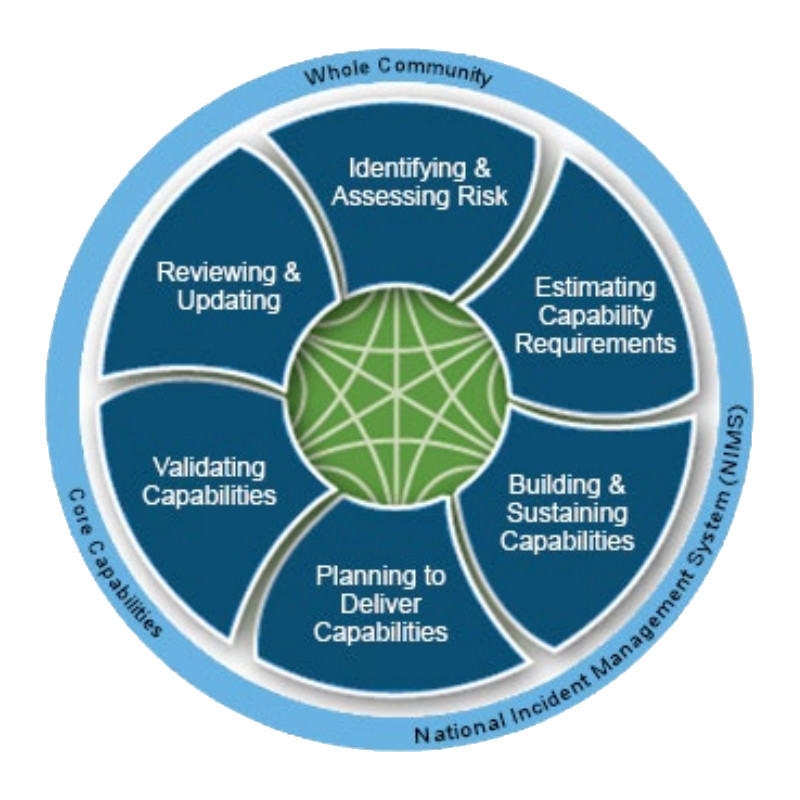
The National Preparedness System also contains Five Mission Area Frameworks (which correspond to the previously mentioned Five Mission Areas.) Exactly how the Five Mission Area Frameworks, one of which is the National Response Framework, fit into the system is more than a little unclear.
It would seem that the National Response Framework would fit into the Planning to Deliver Capabilities part since response largely concerns delivering a service, and some of the literature seems to depict this. But in practice, it would seem that the five frameworks would likely overlie the six parts, some more than others.
Picture the system as a circular, multi-story building designed by multiple architects each having his or her own intractably held opinion on what needs to go where.
The National Response Framework
The National Response Framework is described somewhat differently in different parts of the student manual. At the beginning, it is described as "a guide to how the nation responds to all types of disasters and emergencies." Towards the end, it is described as "doctrine for how the Nation responds to all types of incidents." Guide or doctrine, the National Response Framework is system with multiple vague components.
The National Response Framework Structure
The National Response Framework establishes a "response vision" through five key principles. These are listed below as they appear in the student manual with translations in parentheses.
- Engaged Partnership (Everyone works together.)
- Tiered Response (Manage incidents at the lowest organizational level possible, and call for help only if needed.)
- Scalable, Flexible, and Adaptable Operational Capabilities (Use a response level equal to the incident and be prepared to change the level up or down.)
- Unity of Effort Through Unified Command (Leaders work together without bickering.)
- Readiness to Act (Everyone responds, and no one slacks off.)
To assist response partners, the National Response Framework has certain responsibilities. These are listed next, again with translations in parentheses.
- Identify capabilities that are essential for response and community lifelines stabilization.
(Set priorities and figure out what is needed to address them.) - Indicate the actions necessary to build and deliver the required capabilities.
(Figure out what needs to be done.) - Describe key roles and responsibilities for integrating capabilities across the whole community.
(Figure out who needs to do what.) - Outline how the Response mission area relates to other mission areas.
(Organize resources including persons.)
FEMA calls the top priorities in a disaster Community Lifelines. Community Lifelines are often intertwined. Stabilizing them are the ends of what responders are trying to accomplish. There are seven:
- Safety and Security,
- Food, Water, and Sheltering,
- Health and Medical,
- Energy (Power and Fuel,)
- Communications,
- Transportation,
- Hazardous Material.
The ways, or methods, to achieve these ends are called Core Capabilities. There are various means, or organizations and people, to link the core capabilities to Community Lifelines.
Core Capabilities
Let us step back for a moment to the National Preparedness Goal. The National Preparedness Goal identifies general resources called Core Capabilities. These are abstract tools to achieve the National Preparedness Goal's Five Mission Areas: Protection, Prevention, Mitigation, Response, and Recovery. There are 32 core capabilities. They are listed below primarily to show how some capabilities are compounds of multiple nouns.
You do not need to memorize them, but you should be able to recognize one when it is brought up:
- Planning
- Public Information and Warning
- Operational Coordination
- Forensics and Attribution
- Intelligence and Information Sharing
- Interdiction and Disruption
- Screening, Search, and Detection
- Access Control and Identity Verification
- Physical Protective Measures
- Cybersecurity
- Supply Chain Integrity and Security
- Risk Management for Protection Programs and Activities
- Risk and Disaster Resilience Assessment
- Community Resilience
- Long-term Vulnerability Reduction
- Threats and Hazards Identification
- Environmental Response/Health and Safety
- Critical Transportation
- Situational Assessment
- Fatality Management Services
- Fire Management and Suppression
- Infrastructure Systems
- Logistics and Supply Chain Management
- Mass Care Services
- Mass Search and Rescue Operations
- On-Scene Security, Protection, and Law Enforcement
- Operational Communications
- Public Health, Healthcare, and Emergency Medical Services
- Health and Social Services
- Economic Recovery
- Natural and Cultural Resources
- Housing
A FEMA chart shows how the Mission Areas and Core Capabilities are related. Three core capabilities; Planning, Public Information and Warning, and Operational Coordination; are necessary to meet all of the Mission Areas and are called cross-cutting core capabilities. Since we are dealing only with response, the 15 core capabilities that fall under that heading are the ones that we need to pay special attention to:

To clarify, the fifteen core capabilities for response are:
- Planning
- Public Information and Warning
- Operational Coordination
- Infrastructure Systems
- Critical Transportation
- Environmental Response/Health and Safety
- Fatality Management Services
- Fire Management and Suppression
- Logistics and Supply Chain Management
- Mass Care Services
- Mass Search and Rescue Operations
- On-Scene Security, Protection, and Law Enforcement
- Operational Communications
- Public Health, Healthcare, and Emergency Medical Services
- Situational Assessment
A depiction of how these 15 core capabilities relate to the National Response Frameworks priorities of the Seven Community Lifelines is below.
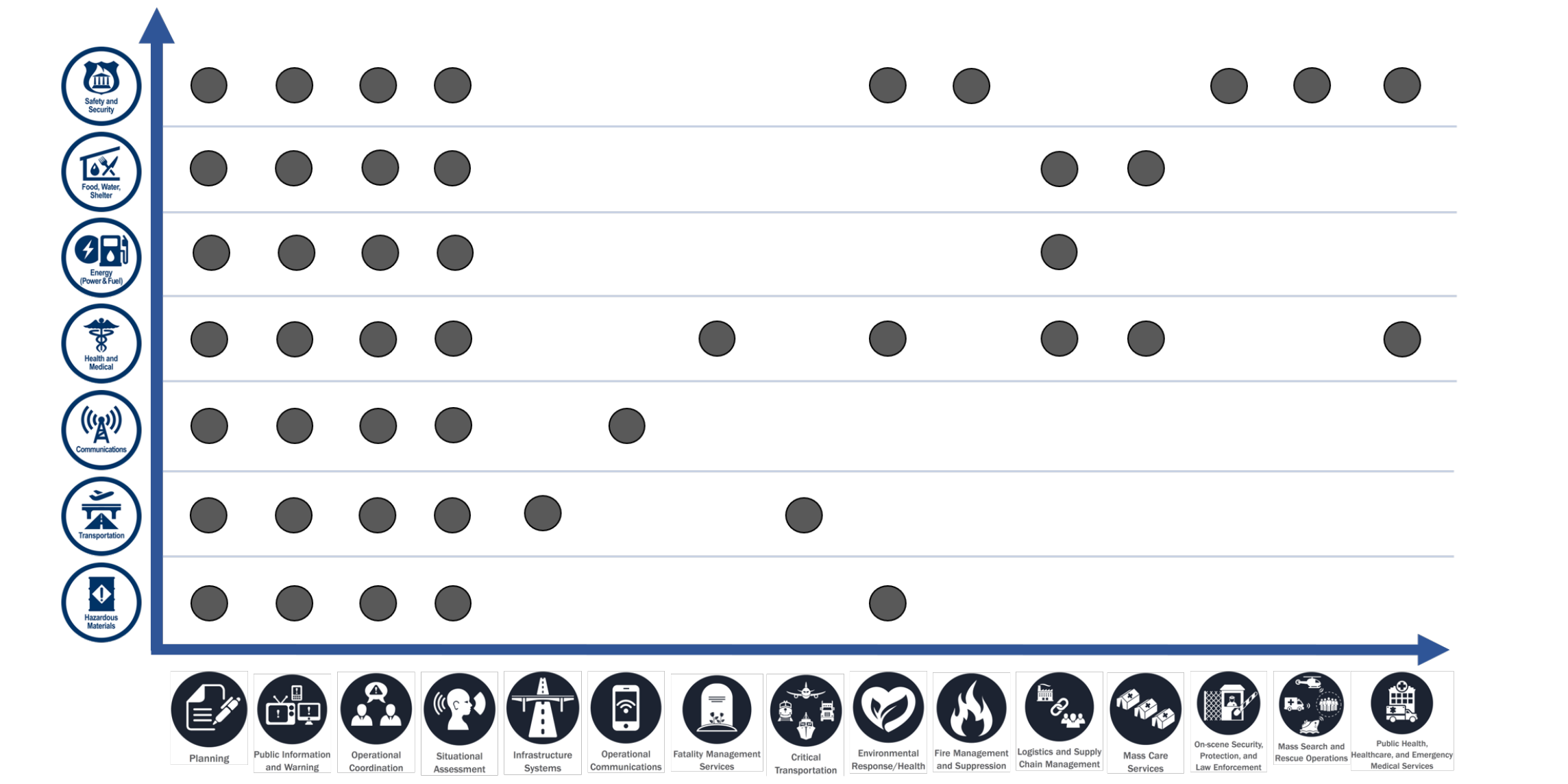
Coordinating Structures
A coordinating structure is a response system management component. It is a FEMA name for an organization to link the core capabilities to Community Lifelines.
A coordinating structure could a place or persons, or rarely, one person. It could also be governmental, charitable, business, ethnic, or fraternal. The term is usually used in reference to large incidents; however, the basic ICS management structure and the incident command post (IPC) are two examples of coordinating structures. There are many different types of coordinating structures. FEMA classifies the governmental ones as local or federal.
Two noteworthy local coordinating structures are Emergency Operations Centers (EOCs) and Multiagency Coordination Groups (MAC Groups). One is a place, the other is human:
An EOC is a "physical location where multi-agency coordination typically occurs...to solve problems." A MAC Group is a group of senior officials who are authorized to spend resources in support of incident activities. A MAC Group may be located at an EOC. I suppose it could also be dispersed and connected electronically. The Tribal Assistance Coordination Group (TAC-G) is a specific type of MAC Group that exists to assist federally recognized Indian tribes during emergencies. There is only one. It is under to control of the DHS, but the student manual includes it with local coordinating structures.

Federal coordinating structures can also be places or persons.
The student manual states that there are 9 federal operation centers, yet it lists 10. (I suspect that someone overlooked the TAC-G's operation center.) Some of these centers are not just for emergency response but are also used for monitoring.
Six are under DHS/FEMA control:
- Cybersecurity and Infrastructure Security Agency (CISA)
- Integrated Operations Coordination Center (CIOCC)
- National Operations Center (NOC)
- National Response Coordination Center (NRCC)
- Regional Response Coordination Center (RRCC)
- Joint Field Office (JFO.)
Two are under FBI control:
- Strategic Information and Operations Center (SIOC)
- Joint Operation Center (JOC.)
Two others seem to be under the control of the Defense and State Departments:
- National Military Command Center (NMCC)
- National Policy - The National Security Council (NSC.)
The number of operation centers stated in the student manual is somewhat misleading. According to certain parts of it: "Most Cabinet-level departments and agencies have at least one Headquarters-level operations center;" moreover, "Each of FEMA's 10 regional offices maintains a Regional Response Coordination Center (RRCC)." If that is not confusing enough, a Joint Field Office is described as a "temporary Federal facility."
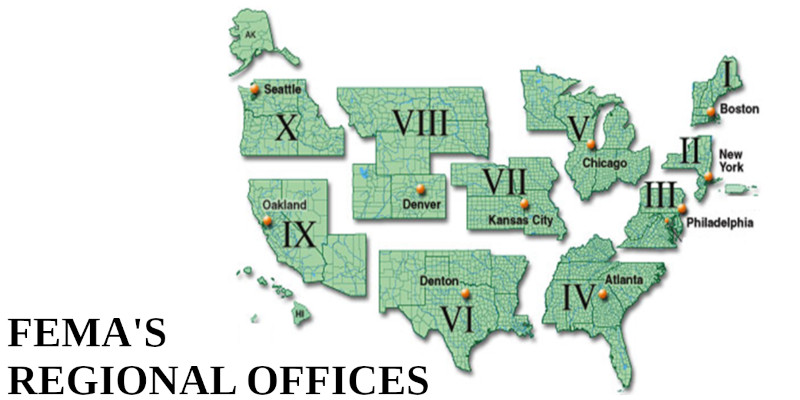
An example of a federal human coordinating structure is a Unified Coordination Group (UCG,) which seems to be an analog of a local MAC Group. If everyone gets along, a UCG should function as a unified command in an ICS-like organization.
Emergency Support Functions
Emergency Support Functions (ESFs) are other forms of coordinating structures. These exist toward the tactical, or hands-on, level and are organized groups of government and private-sector entities that provide personnel, supplies, facilities, and equipment. A federal department, bureau, or agency is designated as the coordinator of each group. Note that some of these coordinators are in reality combinations of coordinators. An abbreviated list looks like this:
- Transportation
Coordinator: Department of Transportation - Communications
Coordinator: DHS/Cybersecurity and Infrastructure Security Agency - Public Works and Engineering
Coordinator: DOD/U.S. Army Corps of Engineers - Firefighting
USDA/U.S. Forest Service and DHS/FEMA/U.S. Fire Administration - Information and Planning
Coordinator: DHS/FEMA - Mass Care, Emergency Assistance, Temporary Housing, and Human Services
Coordinator: DHS/FEMA - Logistics
Coordinator: General Services Administration and DHS/FEMA - Public Health and Medical Services
Coordinator: Department of Health and Human Services (HHS) - Search and Rescue
Coordinator: DHS/FEMA - Oil and Hazardous Materials Response
Coordinator: Environmental Protection Agency - Agriculture and Natural Resources
Coordinator: Department of Agriculture - Energy
Coordinator: Department of Energy - Public Safety and Security
Coordinator: Department of Justice/Bureau of Alcohol, Tobacco, Firearms, and Explosives - Cross-Sector Business and Infrastructure
Coordinator: DHS/Cybersecurity and Infrastructure Security Agency - External Affairs
Coordinator: DHS
The class manual provides an illustration of example actions that an ESF could take. It needs to be emphasized that this illustration, while somewhat useful, only applies to one of the seven Community Lifelines: Health and Medical.
Operational Planning and Miscellaneous
There are several parts to the student manual that do not fit neatly anywhere. One of these is Operational Planning.
Operational Planning seems to have something to do with Federal Interagency Operational Plans (FIOPs) which "describe how the Federal government aligns resources and delivers core capabilities to reach our shared National Preparedness Goal." The way I see it FIOPs are largely plans for imaginary events that, though unlikely, would have significant or even catastrophic consequences.
I assume that a Core Advisory Group (CAG) is another planning structure although it could also be a response structure. A ranchers' CAG, for example, might be able to help prioritize the rescue of animals by pre-identifying those that would need rescuing first.
"FEMA's Incident Management Assistance Teams (IMATs) are rapidly deployable emergency response teams full time, rapid response teams that can arrive at an incident within 12 hours from deployment notification to support the State and Federal Coordinating Officers in establishing the Incident Action Planning (IAP) process and Initial Operating Facility (IOF)."
IMATs are trained to manage "Level I, II, and III incidents." I suppose the "Level" in the IS-800 manual is synonymous with "Type" in the manual for ICS-200. (Remember, there are 6 types of incidents, and Type 1 is the worst:)
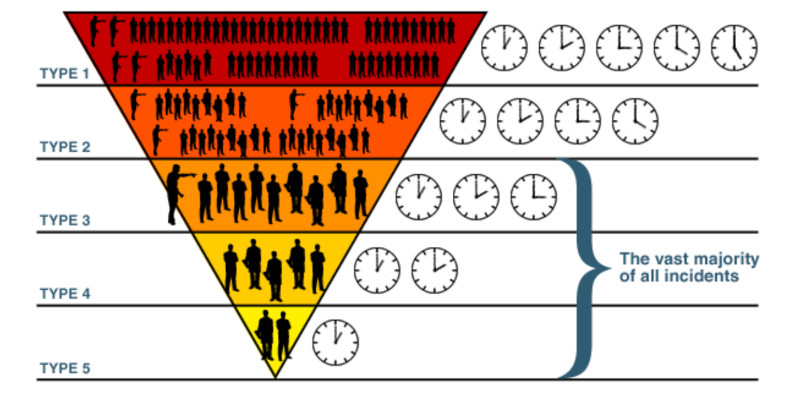
The student manual does not state what an FCO is. I assume FCO stands for Federal Coordinating Officer. The specific role of a FCO or how one gets the title is unclear.
Now Relax a Little
My experience is that the online course is much simpler than the course literature. Although reading the course literature is not a prerequisite, I would suggest skimming it several times before diving into the web-based course. I feel that for most, the faster you progress through the course, the less likely you will be to forget what is needed for the test.
This is because some of the test questions will likely involve recognizing certain words. For example, out of four possible answers, one could be be a word or phrase that should stand out and the others new or obviously wrong. I suppose the test is not unlike many other tests. It is largely to determine that you completed the course and is not a test for expertise.
I found the test much easier than the literature suggested it would be.

